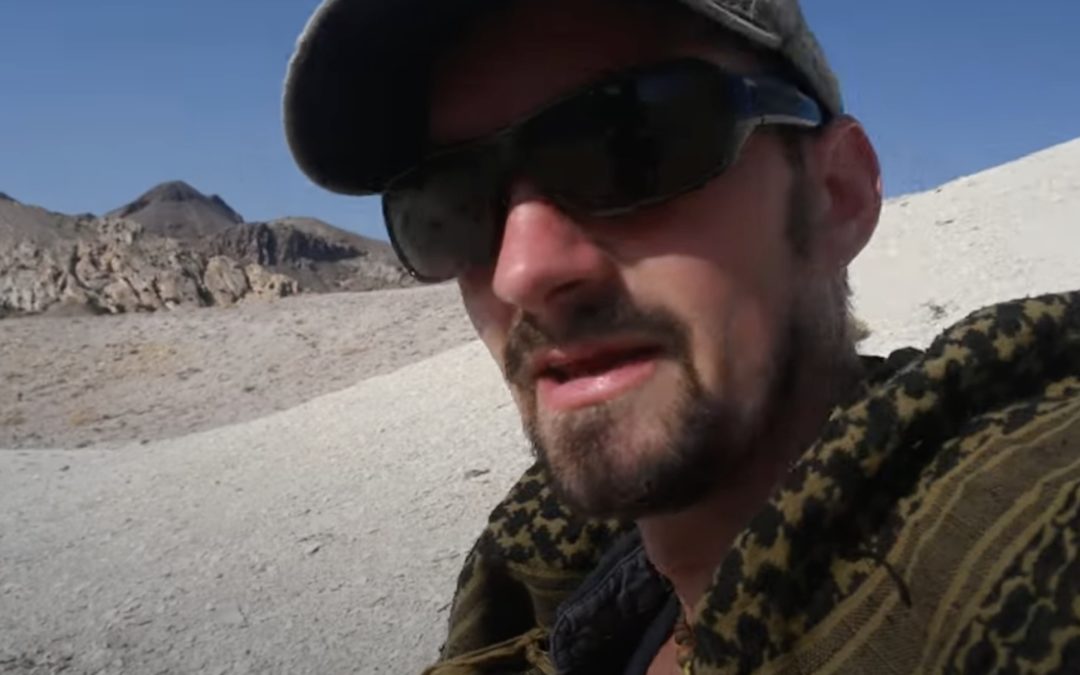This video reports from Rhyolite Ridge in western Nevada, traditional territory of the Walker River Paiute, the Agai-Dicutta Numa, and other bands of the Northern Paiute.
Was it rodents, or was it vandalism? Climate catastrophe or eco-terrorism?
Benjamin R. Grady, the President of the Eriogonum Society, said in a letter that “As distasteful as it is to consider, intentional human action may have caused the demise of thousands of E. tiehmii individuals over the course of two months from July to September 2020. Having studied this genus since 2007, I have visited hundreds of different Eriogonum populations across the American West. Never once have I seen this type of directed small mammal attack at any of those sites. To me, the widespread damage to just E. tiehmii plants was remarkable. The timing of this attack is also suspicious. The threat of a large-scale lithium mine has recently thrust E. tiehmii into the spotlight. This species has been monitored since the early 1990’s and this type of widespread damage has not been documented. While on site on the 23rd of September, I did not notice any scat, with the exception of a few scattered lagomorph pellets. I carefully examined uprooted plants and no actual herbivory was noticed. The green to graying leaves were unchewed and intact. Eriogonum species likely offer little reward of water or nutrients at this time of year.”
Either way, this video is a crime-scene investigation from the middle of the proposed open-pit lithium mine at Rhyolite Ridge, in western Nevada on traditional territory of the Walker River Paiute, the Agai-Dicutta Numa, and other bands of the Northern Paiute.
We don’t know what happened to these plants, but it is clear that they deserve protection. Ioneer’s plan to build an open-pit lithium mine at this site must be resisted.
Transcript
All right. Well, we’re out here at Rhyolite Ridge. This is the site of the proposed large lithium mine that the company Ioneer wants to build here – lithium and boron, specifically lithium for electric car batteries. That’s what’s causing the massive boom in demand.
And we’re actually standing right here on top of the formation of the sterilite, I believe is the name of the mineral. This lithium boron mineral that comes from an ancient lake bed. Sedimentary deposit that’s been turned into the stone right here. This is very high in the lithium and boron that they want to mine. You can feel it. Lithium is a number three on the periodic table of the elements. It’s very light element, and this stone is extremely light. It’s got a lot of lithium in it. It’s actually a metal. Lithium is a metal that floats it’s so light.
And so we’re here on top of this deposit, we just stepped off the road. You can really tell a dramatic difference between that side of the road over there – you’ve got kind of a classic great basin plant community, rabbit brush, bitter brush, a little bit of sage, some grasses – and then over on this side you’ve got very little vegetation. So it’s a very stark difference between these two natural communities here, just on the other side of the road. And it’s because of this unique mineral content in this soil. This is only one of two deposits of this mineral on the planet – this specific soil type – on the entire planet according to Ioneer’s documents. And that unique soil type is what makes this a good habitat for Tiehm’s buckwheat which is the endangered plant. Here’s one right here. So this is the buckwheat. It’s a little more showy in season when it’s blooming but it’s this small little beautiful flowering plant and its entire habitat is between those mountains over there and these mountains over here. So its entire habitat is this basin that we’re in right now. And this is the area that Ioneer wants to turn into a lithium mine.
Essentially, the entire habitat…I believe about 90% of the habitat for this plant. So, you know, we’re out here to check out the site, to get connected to the land here, to build a relationship with this place, to get to know the wildlife, to visit and to help bring this story to others.
There’s an old mineshaft here. Apparently mineral exploration in this area goes back to the 1890s. Mostly just prospecting and so on, not really major production but you see this across Nevada. You get these old abandoned mine sites through a lot of the West, Utah, Colorado, Arizona, New Mexico. You get these old abandoned mineshafts, many of which have major pollution issues and are releasing acid mine drainage and causing all kinds of problems downstream.
So, in this area, the buckwheat has sort of been the focus of the fight even though, you know, I think very much this place would be worth protecting. I would be opposed to this lithium mine if there were no endangered species here. I would be opposed to this lithium mine if there was no life here at all, if it was just a sand desert, I would still be opposed to this lithium mine because I think the integrity of this planet is sacred and I don’t believe in exploiting it for profit in this way.
Here’s more of the buckwheats right here.
So we’re trying to figure out what we think happened to these buckwheats because somebody came out here. Patrick – who’s been fighting this project for a couple years now, advocating for the buckwheat – came out here a little while back and noticed a lot of damage to the buckwheat plants which we noticed as soon as we stepped off the road right down here. We noticed damage to these buckwheat plants. You can see some of it right here as well. These plants have been dug out. This one here is completely unrooted. Look at that. Just comes right out of the ground. It’s been cut off from its roots. This one has been dug around. That one’s been dug around. Right here as well. So, a lot of these plants are dead or dying. That one’s already dead. And so it’s not really clear what happened. So, Centre for Biological Diversity broke the story and they said that they believe it was vandalism – that somebody came out here to intentionally try to destroy these plants. There are only just over 40,000 individual plants in this entire population and about 17,000 or 40% of the population has been damaged or destroyed sometime in the last couple three months. And the mining company Ioneer says that it was rodent damage. I was inclined to not believe that because obviously they have a financial interest, they want this plan to be out of the way. They don’t want want to have to deal with this problem and it really could potentially shut down their mining operation if this plant gets listed as an endangered species and they would be out tens of millions, maybe hundreds of millions that they’ve already spent working on doing feasibility studies and doing test drilling, (we drove by a test drill over here) and so on, in this area. So it’s in their best interest that this plant be out of the way.
So they’re saying it was rodents. I was disinclined to believe that as I said, but Jim over here who’s got a lot more deep experience than I do with the ecology of this region, he said something he’s been seeing lately is rodent damage to plants where this wouldn’t be typical. He talked about cholla cactus. He talked about Joshua trees, more towards Las Vegas in the area where he spent more time. He’s been seeing his rodent damage and he believes it’s related to drought.
This region is being affected heavily by global warming, like the entire Southwest. And this region is in a massive prolonged drought that’s expected with global warming to last more or less indefinitely. It was the hottest summer on record globally, this past summer of 2020 and it was just about the hottest year on record down here in this region as well. It hasn’t rained for six months in this area and the wildlife may be incredibly desperate for whatever moisture they can get and so eating bark, eating green leaves, eating plants that they wouldn’t normally eat in order to just get access to some moisture. So Jim, looking at some of these deposits, some of these damaged plants, thinks that some of them do look consistent with rodent damage but others don’t appear to. There are quite a few plants that have been entirely removed. There’s no remains of them whatsoever. This doesn’t make sense from a rodent damage perspective because the inner core of the plants is woody dry. There would be some remains, one would think. And the other plants – the ones that do appear to be rodent damaged – there’s more consistent pattern with these, where some of the bark has been chewed around the roots. They’ve been excavated out to get down to the juicier part of the roots perhaps, and then chewed…perhaps even broken off from the roots entirely. But, you know, all through this area I’m looking at right down here, there are plants that have been removed completely. This doesn’t seem consistent with rodents. So what we’re thinking at this stage…obviously we don’t know, we’re just speculating…but we’re thinking maybe somebody from the corporation, somebody who’s in favor of the mine, somebody, I don’t know, saw this rodent damage occurring and saw this as an opportunity to destroy more of these plants and pretend that it was rodent damage essentially to promote the damage that is being done by climate change to this fragile natural community and in order to advance their mining interests. So it’s pretty nefarious if that is true. It’s something that I certainly would not put put past people in the mining industry. Nevada has been a very mining heavy state for a long time. Mining interests dominate this state. There are tens of billions of dollars at stake in these lithium mines.
About 11 billion dollars are at stake right here in this lithium mine, in this soil. 11 billion dollars at stake. This plant, right here, this buckwheat, is standing in the way because the endangered species act which has flaws and has problems and hasn’t been able to reverse the ecological crisis, but has been a very important law in this country in protecting some of the environment and stopping a lot of projects, in slowing down developers, in forcing some consideration of the natural world.
So I’m really grateful to the buckwheat for growing in this incredibly inhospitable location, for growing in the soil where no one else can grow. And we’ll see what else we find. We’re going to explore more of this area. There are other populations and different zones. We’re trying to just pick our way carefully here through the plants, not step on anything, not cause any additional erosion or damage to the area, and get the story out.


Recent Comments